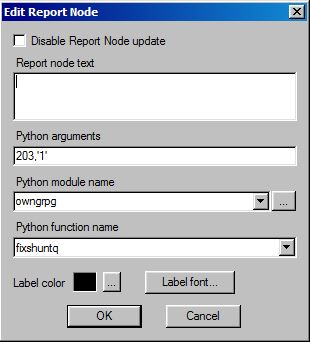Revision history [back]
 | 1 | initial version |
The following script shows two functions that can be used to show the nominal reactive power for fixed and switched shunts respectively in Slider diagrams.
import psspy
def fixshuntq(ibus,id,string='NOM',unit='Mvar'):
ierr, cmpval = psspy.fxsdt2(ibus, id ,string)
if ierr>0: return 'Error %s: fixed shunt %s at bus %s' % (ierr,id,ibus)
return str(round(cmpval.imag,1))+' '+unit
def swshuntb(ibus,string='BINIT',unit='Mvar'):
ierr, rval = psspy.swsdt1(ibus,string)
if ierr>0: return 'Error %s: switched shunt at bus %s' % (ierr,ibus)
return str(round(rval,1))+' '+unit
If the script is called "owngrpg.py" the function to show the fixed capacitor is called in the following way:

Here the first two arguments defining the bus number and shunt id are entered, while the rest keep their default values. This writes the nominal value of the shunt to the diagram.
It is the same principle for a switched shunt (function swshuntb), but here only the bus number is given as argument.
The arguments string and unit make it possible to write any other quantity returned by fxsdt2 or swshuntb.
 | 2 | No.2 Revision |
The following script shows two functions that can be used to show the nominal reactive power for fixed and switched shunts respectively in Slider diagrams.
import psspy
def fixshuntq(ibus,id,string='NOM',unit='Mvar'):
ierr, cmpval = psspy.fxsdt2(ibus, id ,string)
if ierr>0: return 'Error %s: fixed shunt %s at bus %s' % (ierr,id,ibus)
return str(round(cmpval.imag,1))+' '+unit
def swshuntb(ibus,string='BINIT',unit='Mvar'):
ierr, rval = psspy.swsdt1(ibus,string)
if ierr>0: return 'Error %s: switched shunt at bus %s' % (ierr,ibus)
return str(round(rval,1))+' '+unit
If the script is called "owngrpg.py" the function to show the fixed capacitor is called in the following way:

Here the first two arguments defining the bus number and shunt id are entered, while the rest keep their default values. This writes the nominal value of the shunt to the diagram.
It is the same principle for a switched shunt (function swshuntb), but here only the bus number is given as argument.
The arguments string and unit make it possible to write any other quantity returned by fxsdt2 or swshuntb.
EDIT: The total shunt contribution at a bus is written with the following function:
import psspy
def busshunt(ibus):
ierr = psspy.inifxs(ibus)
totq = 0.
while True:
ierr, id = psspy.nxtfxs(ibus)
if ierr>0: break
ierr, cmpval = psspy.fxsdt2(ibus, id ,'ACT')
totq += -cmpval.imag
ierr, binit = psspy.swsdt1(ibus,'BINIT')
if ierr==0:
ierr, vpu = psspy.busdat(ibus ,'PU')
totq += binit*vpu**2
return str(round(totq,1))+' Mvar'
Here capacitors are written as positive reactive power. Change in code if you want opposite sign.

